This blog post is not titled “How to Price Your Art.”
There are many articles of that kind on the internet, but they attempt to be prescriptive, yet applicable to all kinds of artists. They fail to explore the nuances relevant to already-working artists, instead catering to artists making pricing decisions for the first time.
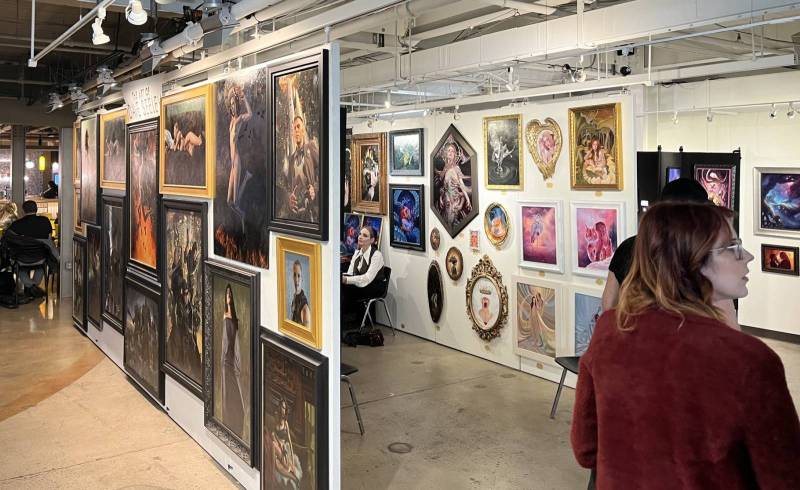
Photo at IX Arts by Jacob Walker
IX Arts 2024 was last week, and it is a wonderful event for deep conversation. Focused on Imaginative Realism, it provided an opportunity to discuss pricing practices and opinions that were specific to our industry. Over the course of the week of IX, I spoke with (and occasionally sat down and interrogated) several Main Show artists and collectors. These discussions were entirely about the sale of traditional original artwork, as opposed to commission rates, licensing costs, or other ways artists monetize their work. Most of us dip our toes into more than one of these, but original artwork sales are often the most opaque.
Our discussions revealed commonalities, a wide range of thoughts, and a few surprising anecdotes.
OBJECTIVE PRICING FACTORS
Objective pricing factors are those can measure, assess, and affect directly. These are applied independently for each individual work of art, and are the first things we think of when we discuss pricing.
When speaking to artists at IX, I heard that they generally priced their work one of two ways:
- First on size, and then adjusted for effort/time/results
- First based on effort/time/results, then adjusted for size
SIZE
When talking to collectors about pricing, it was surprising to me that for most, size was the first thing they considered when judging a fair price. “It is easier to justify a high cost on a larger piece because it casts a wider aura to be enjoyed throughout the room,” one said.
Every one of them I asked about size said space was an issue, to varying degrees. Some said they would move or replace an existing painting if they found one they were in love with that was better for the space. “Large could be a detracting factor, especially when the artist normally works small and then created something much larger than they normally would, for no clear reason,” another shared. “However, if an artist always worked large, it’s easier to accept that if I want that artist’s work on my wall, I’ll have to make the space.”
Of the artists who determined price initially from size, some were more formulaic, while others were guided by how their recent work was priced. In all cases, the number placed on a piece of art was non-linear.
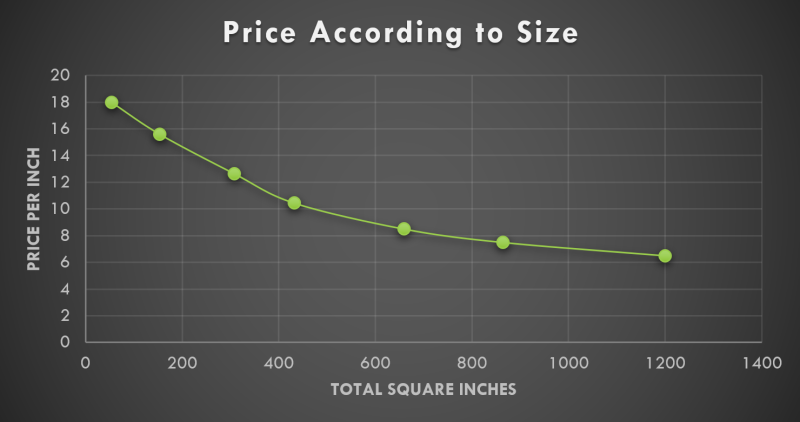
A graph that an artist primarily guided by size might use.
As a rule, smaller work was more expensive per square inch.
A large part of the effort in creating a piece of art is in the planning: the design of the composition, the choice of color, and the reference gathering. Those efforts occupy the same time and effort on a small piece as a large one. Both are 432 square inches, but an 18” x 24” does not take the same effort as eight 6” x 9” paintings.
Of those I spoke with, artists who based their price first on size did not strictly adhere to a per-square-inch rate, instead using it as a starting place. From there, a piece might be priced higher for more detail and care, or if the artist perceived it to hold significant improvement over previous work.
TIME/EFFORT
Some artists set their price first from the effort that went in, only secondarily accounting for size. None recorded the time spent, instead intuitively judging effort, and adjusted from there.
Artists that rejected size-first pricing often cited the effort that goes into a smaller works.
Aedan Roberts feels that small art is usually undervalued, so he sets his price point for tiny art higher, to communicate that they’re not budget versions of his large paintings. These tiny paintings get his full attention, and he nests ornate frames to give them a larger footprint and attract notice from greater distance.
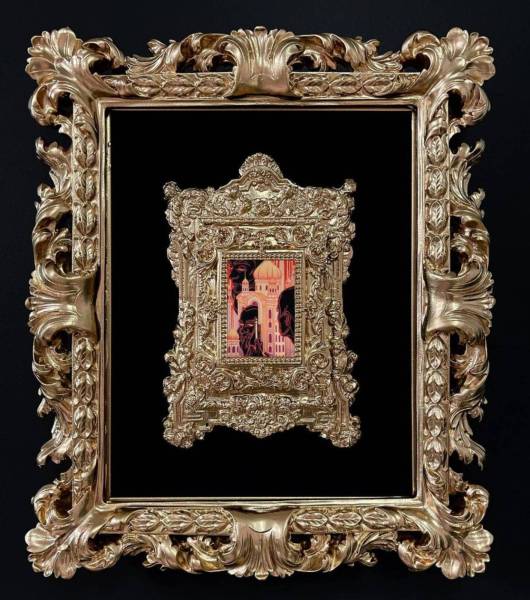
Umbumbratio Historia by Aedan Roberts
Amongst art collectors, there was a wider variety of opinions on how time and effort should be accounted for in pricing.
“I don’t care how long a piece took the artist. If pouring a year’s worth of extra effort into a bad drawing cannot raise the value of it, then efficient work on a masterpiece would not devalue it.” That may mean the artist’s originals aren’t making a living wage, in which case, they felt the artist should address the work quality or their speed.
Another said “Time and effort shouldn’t be a significant factor, but when I see art with considerable detail, or learn the care and extent the artist went to in creating it, I can’t help but perceive it as more valuable. I also can’t help but feel less impressed when I learn an artist executed a painting quickly.”
“Process matters,” a third told me. “I’m happy to pay a premium for work when the creation requires extra effort. Eric Fortune’s work wouldn’t be the same without 11 million delicate layers, and I’m happy to pay for it if anything less and the art wouldn’t be what it is.” In contrast, they recounted a time an artist described struggling with a piece of art, spending many extra hours on it to get it right…and their thought at the time was that the artist was overcoming a fault, not describing a feature.
“I shouldn’t pay more because you couldn’t get the face quite right without multiple attempts.”
PUBLISHED WORK
Whether the artwork has been published or not can have a significant impact on its price.
Collector communities have sprung up around particularly popular IPs, creating their own selling processes, etiquette, and price points. Publishing doesn’t have to be associated with an IP, however, and in the minds of some collectors, inclusion in an annual or similar was appreciated.
There’s often a lot of interest in discussing Magic: The Gathering sales, when artists gather. I’ve been selling MTG paintings for 4 years now, and I still only partially understand it. Since the sale of original work associated with comics, MTG, literary IPs, etc. each operate under their own rules, I am not going to speak to those nuances.
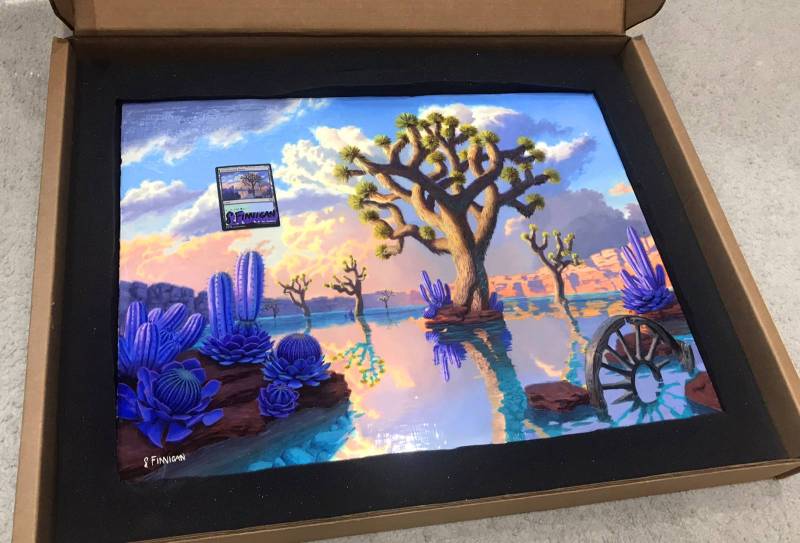
Overflowing Basin by Sarah Finnigan
What can be said is this: An artwork’s association with a product has a profound effect on the value.
Often, we see that as an advantage, but it can work in the negative as well. In an unflattering example: as the MTG market has cooled off in the last two years, I lowered my asking price on a painting to where it would be priced if it was not done for Magic. An interested party pushed back on the price because art on a similar card had publicly auctioned for half of what I was asking. While I chose to decline their offer, this is a real example of a situation where association with an IP devalued the artwork.
Artists coveting work for MTG and other IPs should be wary. The art fetching conspicuously high prices are those most prominently featured, most important to the fans, or are coming from artists considered within that fandom to be ‘premier’ artists. Flashy sales confuse the fact that much of the art made for a product sees little increase in sales price, and sometimes, a piece fails to appeal to collectors due to the subject matter or art direction that the product required.
On average, though, published art and especially association with a popular IP drives a boost in final price.
Artists should not stress about this! Personal work benefits from adequate time and care (i.e., no client deadline), and the artists’ selection of subject matter and execution. It can be published later instead, in an annual or through licensing.
One collector I spoke to said that while being published wouldn’t change whether or not they loved and wanted a piece of art, they did factor it in when it came to pricing. Knowing an artwork was published and had been out in the world and seen gave them peace of mind. They may be more enthusiastic when the art is associated with something they love, but publishing of any kind protected its value on the secondary market.
*IP is short for Intellectual Property.
SUBJECTIVE PRICING FACTORS
Many of us artists avoid discussing our professional reputations directly.
I suspect that we avoid it because we would like to think the art should speak for itself. It seems that there’s much more to it than that.
In addition to those objective traits above, many other factors contribute to how an artists’ body of work is valued. While Artists cannot directly change these factors, there are lessons to learn, and practices we can adjust to influence the pricing of our art.
SECONDARY MARKET
Repeatedly, I heard that resale-ability on the secondary market matters. A lot of artists assume, when the secondary market is brought up, that asset appreciation is the goal.
However, across the board, the goal was value retention.
Value retention made justifying a purchase easy. “When you’re confident that you can sell the artwork, if needed, for 90% or more of what you spent, art doesn’t feel like an expensive purchase. It feels rational,” someone told me. “If the artist didn’t have resale potential, that money is sunk and lost.”
“If ten other people are after a painting,” another collector told me, “you know you can trade it off later if you need to or if you outgrow it. Sometimes other collectors will leave an open offer in case you ever want to sell in the future. So spending $5000 on a painting feels like spending a few hundred at most, and if the art gains value, it’s even easier to justify spending that extra money on more art.”
Collectors overwhelmingly conveyed that they didn’t seek to buy art as an investment, but instead to own it as an expression of their love for the craft. The art’s ability to hold value over time just made it easier for them to collect more of it.
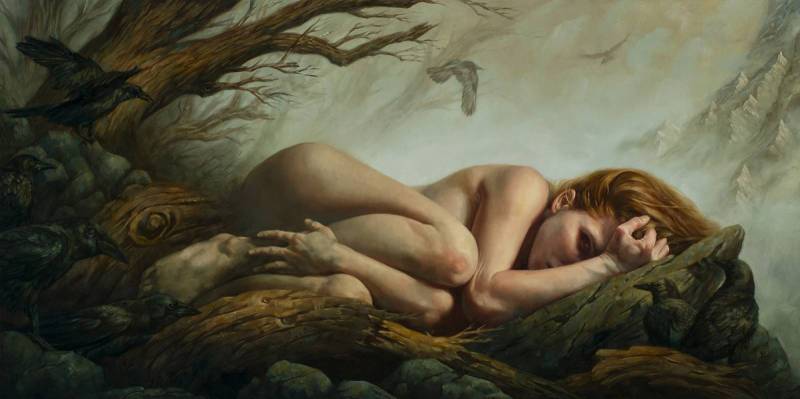
Haven by Michael C. Hayes
What, then, is our role as artists in protecting and improving the value of our work over time?
When I asked collectors how they saw artists affecting this, most described what an artist should NOT do. Art has perceived value, and some very small actions can influence that perception.
DISCOUNTS & ASKING FOR THE SALE
When an artist ‘asks’ for the sale, it changes the collector’s opinion of that artist’s body of work.
They said they couldn’t help but equate the practice with used car salesmen. It capped the reputation of the artist in their mind, to a lower max price. If they like the art, they’ll still buy it, but they are more likely to make lower offers.
An art collector recounted an artist who, to avoid shipping the work home after an event, was happy to accept a steep discount at the end of the weekend. “Another artist I regularly saw would ask what discount it would take for me to walk away with the painting. I liked the painting, but once I knew the artist would do that, I would never again pay full price. Why should I? They showed me that their price was arbitrary and that the artwork lacked demand.”
This art collector specified that deals are fine, and can make them feel privileged when the artist did it correctly.
“I liked the painting, but once I knew the artist would do that, I would never again pay full price.”
The circumstances could still be that the painting is older and the artist would prefer not to ship it home. The difference comes in whether or not the deal is done privately and feels specially granted to the collector individually, as opposed to being offered to anyone who walks by. When circumstances make sense and it’s a win for both parties, they feel like they got something special because of their relationship with the artist. In their opinion, artists should never run sales on original artwork, where art is publicly discounted. It communicates that the art may be intentionally overpriced and then marked down; they called it the “Walmart treatment.”
PRICING TO MOVE
I often hear artists say they’ve lowered their prices a few hundred dollars to encourage sales at an event. Curious to see how they felt, I asked several art collectors if this practice inspired purchases.
Those I spoke to didn’t view it favorably.
There were exceptions, for new artists or for preliminary work. “Underpricing when someone is new is almost expected, and can be exciting because sometimes I feel like I’ve discovered an emerging artist and can nab a piece before the artist takes off. A sold-out show or quickly moving work does create buzz for someone new,” they shared. “However, the expectation is that next time the art is shown, it has increased in price to reflect that.”
“Some artists show work with promise that falls just short of excellence,” another said. “I might buy, solely to encourage the artist to continue improving. Works I have bought this way have never failed to later improve in my estimation.”
Outside of new talent, a lower price did not appear to entice a sale. I was told repeatedly that initially, the sole consideration is whether or not the collector liked and wanted the art. Only after that would price be considered. If they didn’t already want to own a piece of art, a lower price would not change that.
“I either want it, or I don’t.”
One collector emphasized that if they were enthusiastic about the art, they wanted to pay a fair price for it. On the other hand, if an artwork was above their budget, collectors said they would choose to save up, ask for a payment plan, or make a lower offer. Some collectors expressed that overpricing made the artist seem inexperienced, and that perhaps the artist was priced based on the time it took.
None of the collectors said it would stop them from making an offer if they loved the artwork though.
Several collectors said they got their start with sketches and prelims, and that more financially-accessible preliminary work was appreciated. “I cherish artists who have a bin of low-cost preliminary sketches and color studies, so I can demonstrate my love for an artist’s work without buying the hefty $20K original,” one told me. “Getting my paws grubby while panning for gold, as it were. Children grow into collectors, and can get their start with these high-quality ‘smalls,’ that parents might be willing to purchase.”
COUNTER OFFERS & HAGGLING
The prospect of a haggling collector is a stressful one for many artists. Of the artists I spoke to, the percentage of pieces where haggling was attempted varied between 5% and 50%. A counteroffer is a much friendlier term for what seems (to me) to be the same thing. None of the artists I spoke to would consider a lower offer on newly finished artwork, but most were open to it as a piece aged in their possession.
“I never decrease the public price on older work, but I’ll gladly consider offers. I might even hint that it is an option to someone who is interested in the painting,” Michael C. Hayes shared.
Of course, not all work should necessarily decrease in cost with age. The volume of original art sales is very low for all artists, and sometimes the right person takes time to find the right painting. Kaysha Siemens advises, “If a painting is a landmark piece for you, but hasn’t sold, give it time to find its home and stick to your guns.” Larger work too tends to take longer to sell, as can be said in the housing market for bigger, pricier homes. It’s expected, so when a larger piece of art is underpriced “to move,” it can wrongfully communicate that there might be something wrong with it.

Artemis and Hound by Kaysha Siemens
One of the collectors said they felt well-acquainted with art price norms because they made a hobby of following many galleries, attending many events, and followed a multitude of artists carefully. They said that they would only make a [lower] offer if they felt that the piece was overpriced.
Another said they only made counter offers on older work, and only with artists they knew. “If it is hot off the press, and it’s the price the artist wants, I won’t counter. It’s for me to decide if I am happy with the price they want. If it’s a few years old, it’s reasonable to offer less. A lot of artists are willing to let those go for less. Some artists are just uncomfortable with haggling or take offense at it. If I don’t know how an artist will respond, I just don’t do it.”
“The artist knows what price to set,” a third said. “They create magic; it would be rude to counter-offer.”
GETTING TO KNOW THE ARTIST
Meeting the artist behind the work will shift your perspective on it.
It has been fascinating to me to see art I previously didn’t emotionally engage with become appealing as I got to know the artist, their working process, or the meaning behind the work. Similarly, most of us have soured on art we admired after having a bad interaction with its creator. In-person events like IX Arts, gallery shows, and conventions are an opportunity to get to know the artist and how and why they work. If you’re attending one of these as an artist, endeavor to be easy to talk to.
People want to believe in the artist behind the art.
We should never denigrate our work. Collectors recalled several artist interactions where the artist talked about how much better everyone else’s art was, or where the artist insulted their work or apologized for its shortcomings. As is advised for portfolio reviews: don’t apologize for the art. Sometimes we may need to vent our frustrations with ourselves or our insecurities, but those conversations should remain between artists.
I heard several stories of artwork that collectors particularly enjoyed because of the memories they associated with them; paintings that alone did not excite them but were some of their favorites because the art evoked positive emotions stemming from the wonderful conversations held in front of it with the artist.
“They’re not my favorite artist, but they’re my favorite artist to collect from.”
“They’re not my favorite artist, but they’re my favorite artist to collect from, because we resonate,” one told me. “Every time I see them it’s a pleasure and I see that in my art at home.”
Unfortunately, some also had stories of art they passed on or sold because the artist was rude and left a bad taste in their mouth. Even when they had previously adored the work on its own merit, they could no longer see it the same way after an unpleasant encounter.
I once had a fun conversation with someone who owned other work of mine, about a painting I was exhibiting that they particularly disliked. (While this could easily be done rudely, they did an excellent job feeling me out on it first.) Normally I would not speak poorly about my own art in this setting, but there were extenuating circumstances, and I enjoyed finding us both in agreement on something slightly taboo to talk about.
I think the candid nature of the chat must have sat well, because a few weeks later they reached out.
They said they kept finding themselves coming back to it and had warmed up to the painting over small aspects they found common across all of my work…and now they wanted it. I think this is delightful and hilarious, but also a great anecdote for how dramatically personal dynamics can shift how art is viewed.
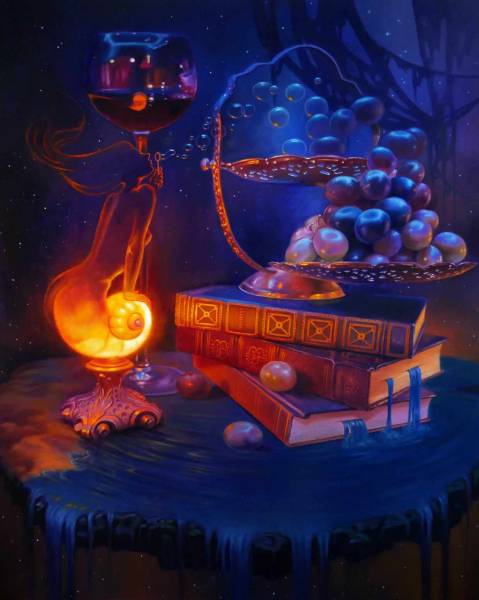
Manifest by Rain Delmar
As in all things, when talking about professional relationships, be kind and authentic. Authenticity is a buzz word in our social-media-soaked landscape, but I don’t mean performative authenticity. People can feel when you’re not being you.
The insights in this post are for artists who wish to confidently price their art and improve their work’s value. It is important to me to point out that you should treat everyone, be they collector, art director, budding artist, or consummate professional, like people.
Unfortunately, I’ve been audience to a conversation or two where those shopping for art are viewed as targets. Being nice to someone solely in hopes of getting something from them is predatory behavior.
Bring no expectations into interactions, except perhaps that you are both fans of art. Nobody’s art is universally liked, so when I meet someone I assume mine may very well not be to their taste. Make friends amongst art collectors and art fans who are drawn to art different from yours.
CONSISTENCY
Consistency implies a rhyme and reason and instills confidence.
A few collectors I spoke to expressed concern when they see widely varying prices on work all by the same artist.
If you are or would like to be working with galleries, it is vital that your prices be consistent everywhere. Artists should not adjust a price to account for the gallery’s percentage. If the prices differ, collectors will be disincentivized to purchase through the gallery, and so galleries would be disincentivized to work with you.
The percentage a gallery takes is meant to account for a valuable service that they bring to the artist, so it is the artist who pays for it. If the gallery’s cut is too much to justify, then working with that gallery should be reconsidered. You should find a gallery that brings value equal to the percentage they’re paid when your artwork sells.
GROWTH
As your skills grow and work improves, your art prices should likewise improve.
Each artist handles growth differently, but almost none of the artists I spoke to ever allowed prices to lose ground. It might seem that if a particularly well-executed piece would be priced a bit higher than others of the same size, an underwhelming or simpler one might be priced below average. This didn’t seem to be the case for most. Underperforming art was usually sold at a lower cost privately, or lowered publicly after adequate time had passed.
For some artists, growth happened when landmark paintings, much better than everything previous, were priced higher. As subsequent works strived to match that success, their prices crept up and became the new normal. For those who increased their prices in this way, collectors were usually not notified of changes since they were done gradually, and price increases only applied to new work.
Others raised their prices on a regular basis, such as annually, to reflect inflation. It may be increased more if they felt their career advancements that year had merited it. Those career advancements could be sold-out gallery shows, major awards, esteemed publications, etc. One artist who handled their work this way applied inflation price increases to past work, and not just to the art done from current date forward.
Up until now, I have increased my own prices in response to demand. I make the shift at the end of the year when things are quiet and no events are happening. I modify prices subjectively, attempting to adjust enough to keep inventory for a reasonable amount of time, but hoping not to over-adjust such that the art stops selling. High demand reflects well when you’re new, but I suspect having low inventory over long periods of time looks amateurish. It’s hard to imagine our art heroes never having work to display.
Pricing is a very personal decision. Every artist’s work is unique, and there is no one right way of approaching it. However you go about it, strive for opportunities that help build familiarity with and confidence in your work, and adjust your prices and your practices to grow your artwork’s footprint on the world.
___
Many thanks to Aedan Roberts, Kaysha Siemens, Michael C. Hayes, Rain Delmar, Phil Li, David Scherban, Shawn Hendricks, and Susan Shwartz for generously sharing your experiences and wisdom, and to all the other folks who briefly weighed in throughout the week of IX!




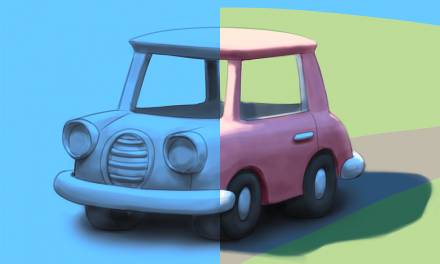


A wonderfully thorough presentation Sarah! Thank you for covering so many aspects, including the collectors positions and thoughts.
Thank you! There always seems be so much conjecture among artists at events, so I hope hearing from collectors can help those who normally don’t get to have those conversations.
Thank you for the nuanced look at all of this, and especially thoughts from collectors. Extremely interesting and helpful all around!
Thanks Hilary!
These conversations were so incredibly helpful for someone like me getting into the market. Thank you so much for this article.
Dang, one more ‘thank you’ for this fantastic and thorough discussion on the topic!
One more thank you here – wow, what an incredibly detailed and informative article! Thank you so much for doing this work, and particularly for interviewing collectors. This is so valuable!